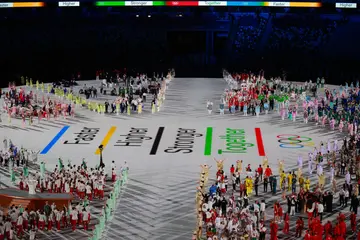Find out who threw the beer at Malice at the Palace. The untold story of Malice at the Palace
NBA
The Olympic flag is an iconic symbol of the Summer and Winter Games. The flag is often ceremonially raised and lowered at the main venue in the presence of participants, officials, and fans. During the opening ceremony, the flag is raised to kick-start the events and lowered at the closing ceremony when the competition ends. The flag consists of unique features and a symbolic design.

The flag has a white background with five interlaced rings in the centre. The rings are of five colours symbolising different things. The flag has a long history and remains one of the main emblems of the Games organised by the International Olympic Committee (IOC).
The flag expresses the activity of the Olympic Movement and the five continents that founded the tournament. It also unifies athletes and fans who travel worldwide to attend the Games.

The Olympic flag and motto are two important symbols of the competition. The traditional motto was "hendiatris Citius, Altius, Fortius," which is in Latin, and "Faster, Higher, Stronger" in English. 1894, Pierre de Coubertin proposed the motto during the formation of the International Olympic Committee.
Find out who threw the beer at Malice at the Palace. The untold story of Malice at the Palace
NBA
In 2021, the IOC modified it to the "Citius, Altius, Fortius - Communiter" motto in Latin and "Faster, Higher, Stronger - Together" in English.

The torch is a sacred tradition that started in 776 BC in Ancient Greece. During those days, people lit flames before celebrations or games such as wrestling, running and equestrian events. Today, passing the torch symbolises peace and celebrates friendship and human achievement.
The Olympic flag was created in 1914 by French international Baron Pierre de Coubertin, the co-founder of the modern Olympic games. The flag got raised for the first time at the 1920 Games in Antwerp, Belgium. Unfortunately, the flag got lost following the Antwerp Games, but they replaced it with another before the 1924 Paris Games.

IOC used the Paris 1924 flag in several Summer Games until 1988. In 1997, the original "Antwerp Flag" was discovered in Hal Prieste's suitcase and returned to the IOC in a ceremony at the 2000 Sydney Games by 103-year-old Prieste.
Ranking the 20 best ice skaters of all time: Figure skating at its best
Other Sports
The idea for the rings came after the 1912 Olympic Games in Stockholm, Sweden. Around 2,400 athletes representing 28 nations from five continents competed for the first time. These are Africa, the Americas, Asia, Europe, and Oceania.

The flag has a white background and interlocking rings in the centre. The Olympic flag rings have different colours vital to the Games' values.
Pierre de Coubertin designed the flag with five rings. The interlocking rings form a unique design that has become the tournament's identity.

Coubertin said the five rings represent five continents, which participated in the 1912 Games. The interlaced rings have equal dimensions, putting all continents at the same level.
Ranking the top 10 best Brazilian football strikers of all-time
Football
The flag has a white background and five rings with different colours; blue, dark yellow, black, green, and red. The colours represent every nation's flag, which participated in the inaugural competition.
The black colour in one of the rings symbolises Europe. Meanwhile, yellow represents Africa, red represents the Americas, and blue represents Oceania. The green colour represents the Asian continent.

Pita Taufatofua has earned a reputation and won admirers for participating in three consecutive opening ceremonies. The Tongan athlete competed in taekwondo in Rio 2016 and Tokyo 2020 and participated in the 2018 Pyeongchang Winter Games as a cross-country skier.
Taufatofua carried his country's flag in the Parade of Nations and stole the show with traditional attire. Sources reveal he is aiming at the 2024 Summer Olympics in France.
Maradona vs. Pele: Who is the greatest footballer of all-time?
Football

Flag football is a high-octane, non-contact version of American football. It is a sport where players make tackles by removing a flag belt on the hips of the ball carrier to end the player down. Flag football is dominant in America and Britain. The International Federation of American Football (IFAF) manages the sport globally.
The IFAF and the National Football League partnered to push flag football in the 2028 Summer Games in Los Angels. Fortunately, the bid received approval from the IOC Executive Board, pending final voting in October 2023.
The Olympic flag remains an iconic symbol of the global competition. During closing ceremonies of the Games, the mayor of the host often hands the flag to the IOC President, who hands it on to the mayor of the next host. The flag of the following host country gets raised to the right of the flag of the current host country alongside the anthem.
What is softball? Rules, history, and facts of the sport
Other Sports
READ ALSO: Who has the highest vertical in the NBA? A top 10 ranked list
Sports Brief also listed the highest vertical players in NBA history. The sport has produced excellent athletes with incredible vertical heights, like Michael Jordan, Darrell Griffith, and Anthony Spud Webb. Most basketball fans worldwide are thrilled whenever they see players making vertical jumps since it excites their lives.
Since its introduction in the 60s, the highest vertical has become a popular stat in the NBA. Learn more in our article through the above link.